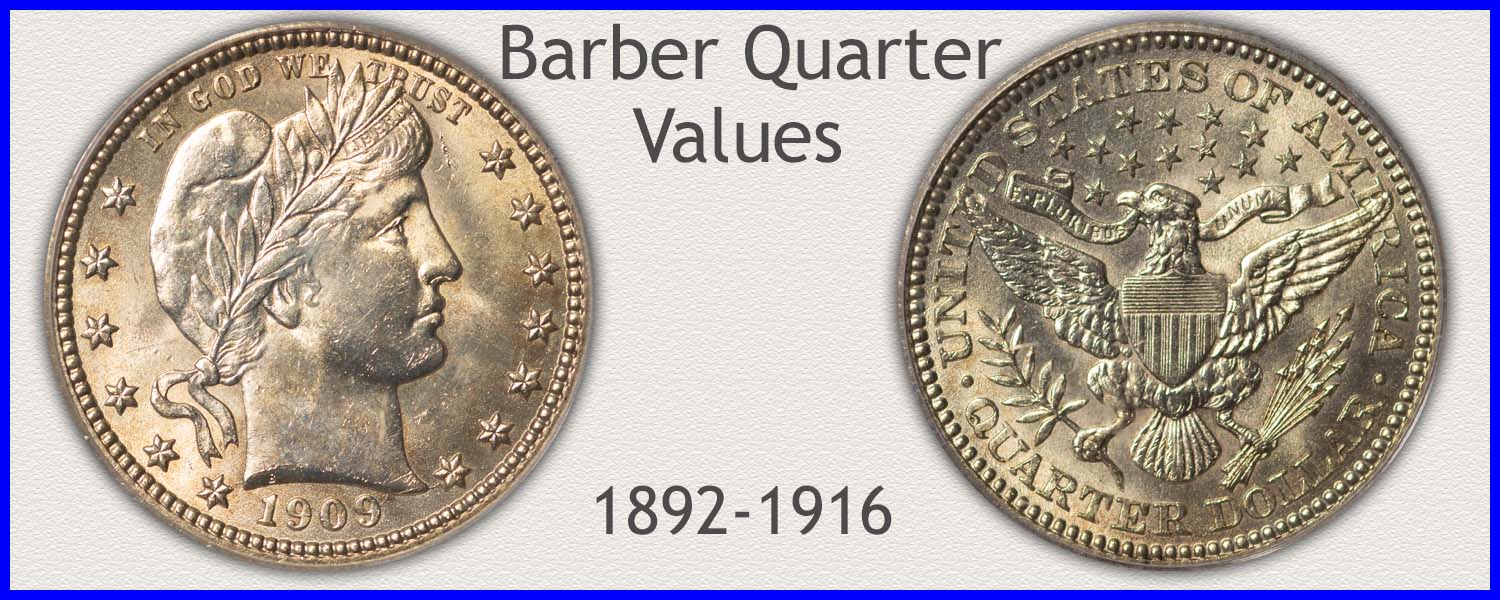Coin Values Moving with Precious Metals: Up-Dated 4/21/2025: Gold $3380 | Silver $32.89
1894 Quarter Value
Collectors place a high value on high-quality vintage quarters. The chart shows that these coins have a premium 1894 quarter value.
In Step 2, the grading section below uses a series of images to compare the various stages of condition. When inspecting your coin and recognizing the critical areas to check, a close judgment of condition is made. When the exact date and mint are added to a grading judgement, a narrow range on the chart is found.
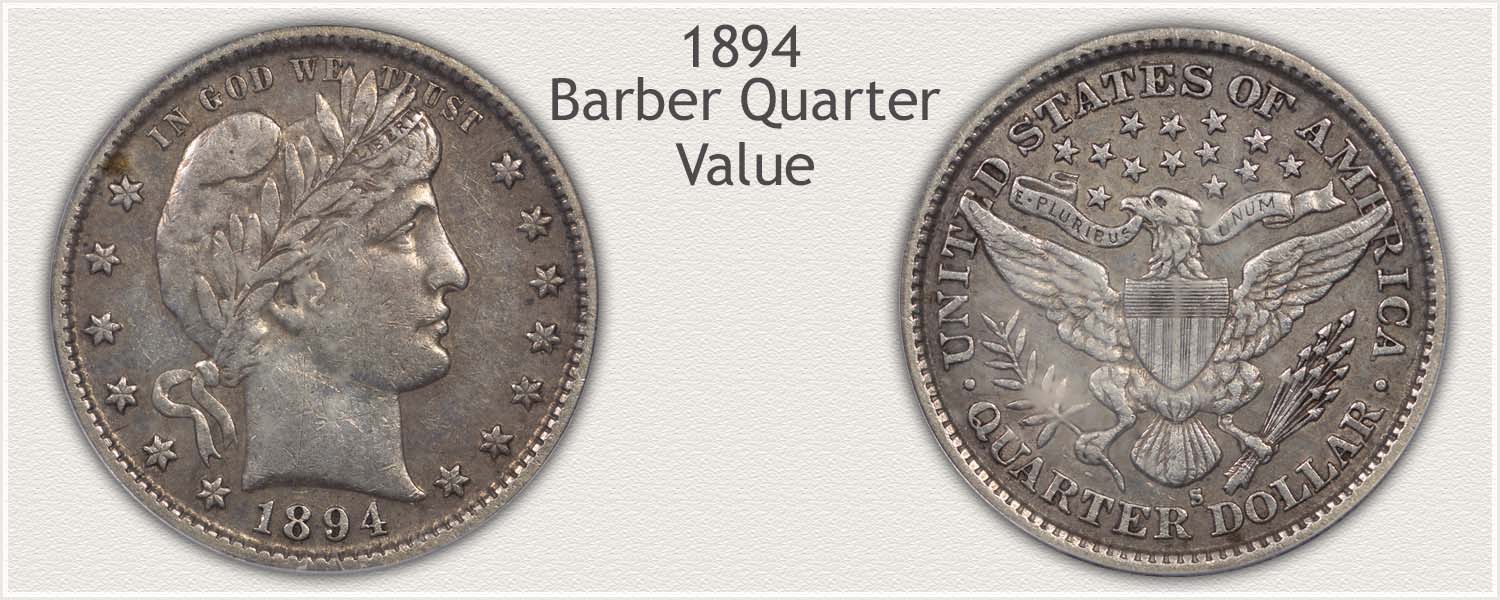
Steps Leading to Value:
- Step 1: Date and Mintmark Variety - A detailed description, providing a full assessment of your coin, is only possible when mintmarks are recognized and identified.
- Step 2: Grading Condition - Condition of collectible coins is used as one factor in the evaluation of coins. Each is given a grade to help locate its position on the value chart.
- Step 3: Special Qualities - Premiums are often raised higher for these Barber quarters when certain qualities are recognized.
| 1894 Quarter Value | ||||
|---|---|---|---|---|
| Condition of Coin | ||||
| Date | Good | Fine | Extremely Fine | Mint State |
| Barber Quarter Values Updated | 4/21/2025 | |||
| 1894 | $9.14 | $36 | $65 | $180 |
| 1894 O | $10.10 | $56 | $167 | $356 |
| 1894 S | $9.14 | $48 | $108 | $381 |
Listed are a range of wholesale values for conservatively graded Barber quarters. Use the steps to grading helping narrow the ranges found on the chart.
Step 1: | Identify Date and Mintmark Combination
Mintmarks to Recognize of 1894 Quarters
Philadelphia mint leads in production of 1894 quarters. Philadelphia's issue is one of three varieties struck in the year. Two additional Branch mints contributed coinage, notably at far fewer numbers.
With the large range in values seen on the chart for both mint variety and condition; a close inspection in needed. Images help confirm the important mintmarks.
1894-S Barber Quarter
"S" Mintmark on Reverse: San Francisco Mint Struck the Coin
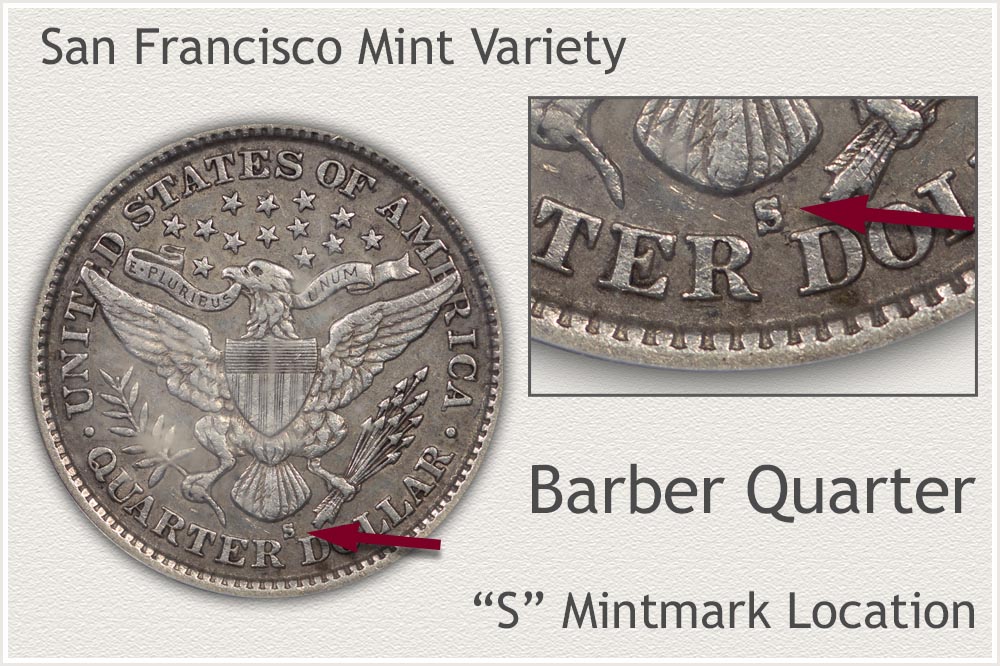
A San Francisco 1894 quarter is an excellent choice to introduce the Barber series to a new or young collector. Sturck in ample quantities: 2,648,821 pieces, these remain affordable today.
A worn example with some detail remaining represents a quarter from a vintage series, minted in the early years of the series, and from the nineteenth century. With the San Francisco mint issues a popular variety, these are in demand. Nice quality pieces with just minor wear are eagerly collected.
San Francisco is a Branch Mint of the U.S. Durning the Barber series the mint placed an "S" mintmark to distinguish its coinage. Turning to the reverse, look for the letter "S" mark below the tail feathers of the eagle.
1894-O Barber Quarter
"O" Mintmark on Reverse: New Orleans Mint Struck the Coin
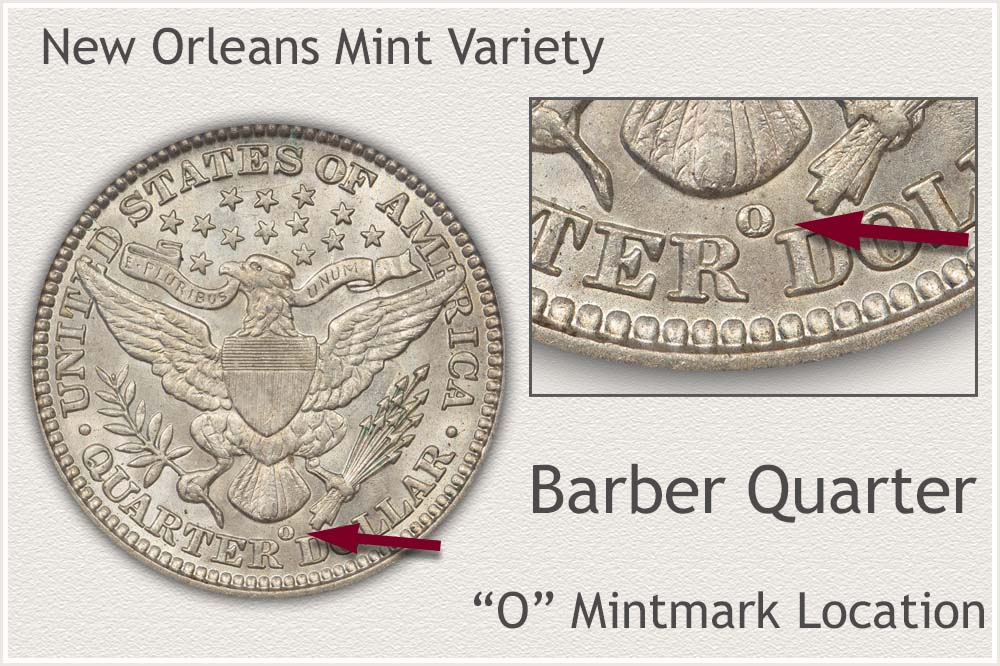
The New Orleans mint contributed to the Barber quarter series in 1894 by supplying the central part of the country. The bulk of quarters for the year were minted at the New Orleans and Philadelphia mints, with New Orleans producing over 2.8 million quarters. A premium collector coin is a nicely detailed example. Also, pieces showing heavy wear are worth a little more than the base value of silver.
Mintmarks placed on branch mint coins are used to distinguish the various mining facilities. The reverse of the example quarter shows the New Orleans mint's mark, a large letter "O."
Above the "R" and "D" in "Quarter Dollar," you'll see the New Orleans mintmark. The "O" confirming the New Orleans mint struck the piece is located just beneath the eagle's tail feathers.
1894 Barber Quarter
No Mintmark on Reverse: Philadelphia Mint Struck the Coin
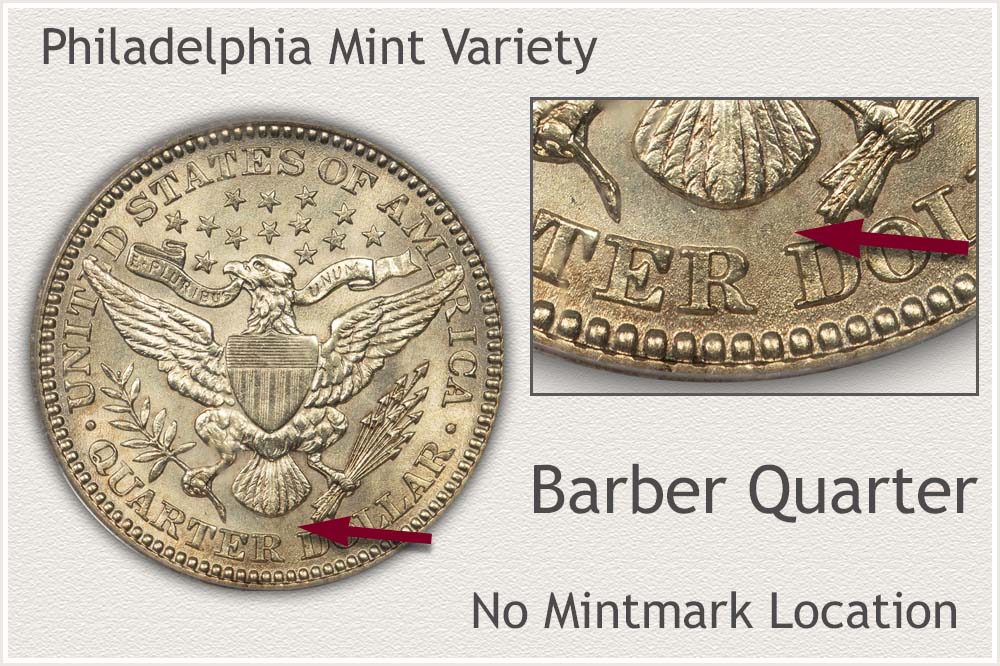
Of the four mints involved in production of Barber quarters, the Philadelphia mint was the only one to strike quarters each year of the series. Of interest to collectors, 1894 represents an unusually low mintage year for the mint, with just 3.4 million produced.
Heavily worn examples remain available; however, nicer quality pieces are notably difficult to find. Scarcity of the better, collector quality coins are awarded strong premiums, as seen on the chart.
Absence of a mintmark is the key indicator for recognizing Philadelphia mint coinage. During the Barber series, no mintmark was placed on coins by the mint. On the reverse, the area above the "R" and "D" of "Quarter Dollar" is empty.
Step 2: | Condition is Judged to Apply a Grade
Images are Compared to Narrow 1894 Quarter Value
Values on the chart demonstrate how important a coin's condition is to its market premium and collectible appeal. The condition is compared to images representing standards of grades to determine the grade. Grades specify conditions.
Compare your coin to the images below. Descriptions focus on significant markers when grading and determining stages of wear.
Mint State Grade
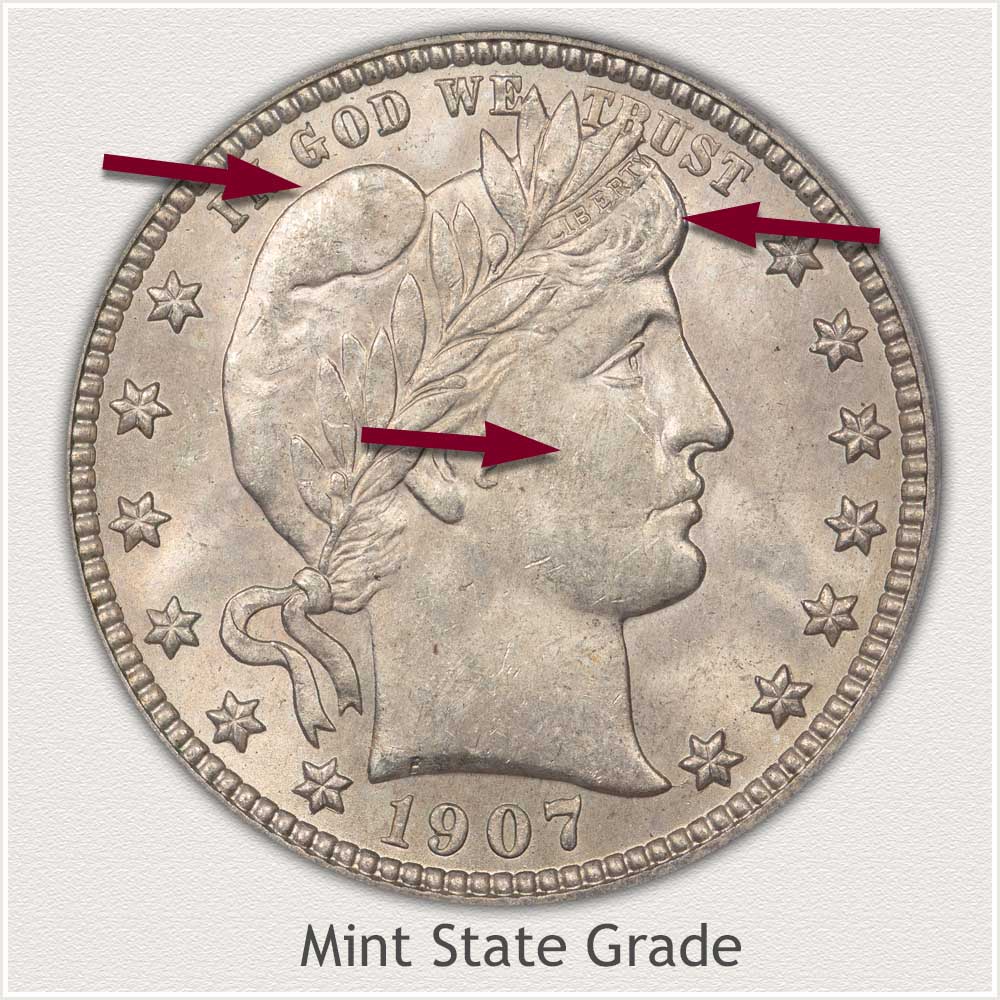
Mint State: Mint State grade is an important condition for a coin to a collector. It represents a Barber quarter with no wear to its surface. It is also a condition with all of the original detail and mint luster intact. A scarce state of preservation for these old vintage series quarters.
With many fine details present in the design of the coin. Inspecting the highest points is done to confirm all are without smoothing or dulling due to wear. Raised fine lines of the hair above Liberty's forehead are examined. Finding mint luster covering the area indicates a mint state condition. Luster is a delicate texture, and easily diminished and dulled when a coin circulates.
Further inspection of the open area of Liberty's cap is helping to confirm no wear. The upper and outer edges of the cap, very high areas, still reflect luster when the coin is tilted and moved under a light.
An overall view shows no deepening grey and smooth areas on the cheek and high areas of her neck. Worn silver on high points becomes a different color and a smooth texture as compared to lower intact luster in recesses of the design.
Extremely Fine Grade
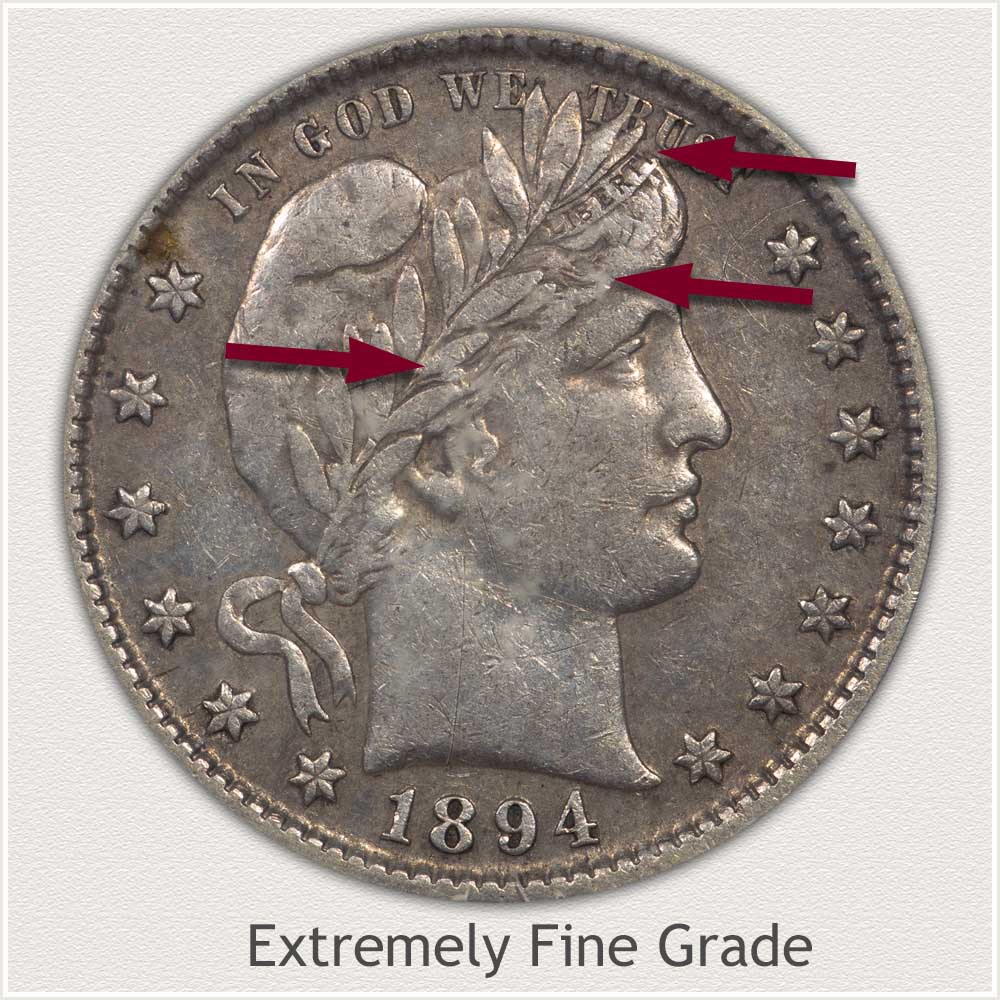
Extremely Fine: A quarter with just a small amount of noticeable wear is defined as Extremely Fine in grade. Within the Barber series, these high condition coins are considered very collectible and sought by many collectors. Original mint luster has been replaced with a soft silver-grey tone to the metal.
An early wear point is the hair just above Liberty's forehead. Fine strands of hair were part of the design; however, many are now flattened with a small amount of blending. Look at both the lower and upper edge of the headband in the area. A well-defined band, separate of the hair, is placing this coin within the grade.
A significant feature of the grade is all leaves within the wreath are strongly outlined with very distinct contours to the leaves. Slight wear is evident confined to the edges of the leaves. Sharp detail is the overall impression of the coin. Lacking any distracting marks, the example is a nice collectible coin for the Extremely Fine grade.
Fine Grade
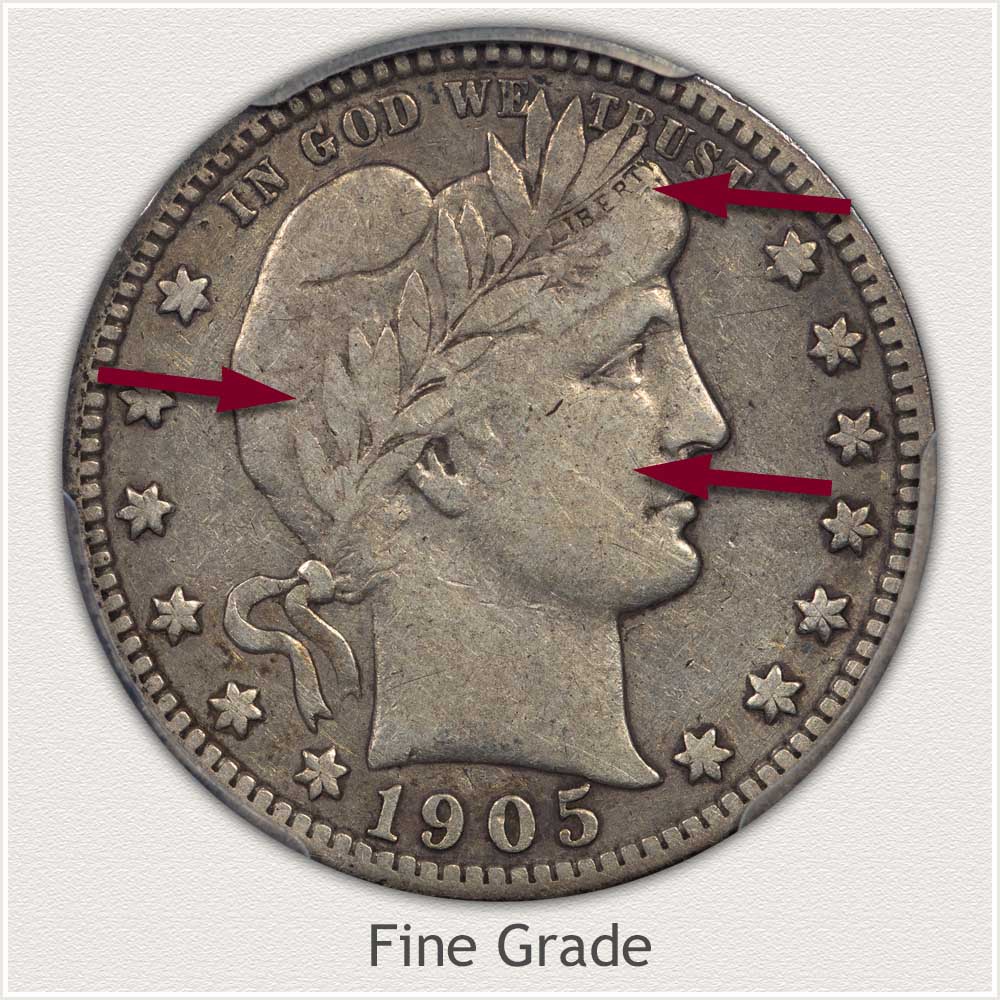
Fine Grade: An important feature of any Barber quarter in Fine grade is the condition of the lettering of "LIBERTY" found in the headband above the forehead. Collectors inspect this area closely to confirm all the letters are visible. Well defined letters help establish the Fine grade.
Using a magnifying glass, inspect the headband and confirm all letters are easily readable. The very highest relief area of the band contains the letters "ER". If these remain bold, the coin is high quality within the grade.
Additionally, smoothing of the metal, because of wear, has flattened all contours of the leaves within the wreath. Once defined by high and low reliefs, each leaf is now a smooth, flat surface. Leaves of the upper row remain well outlined to qualify in Fine grade condition.
Collectible quality continues with strong features remaining in Liberty's portrait. Well contoured cheeks and neck areas identify a coin with only moderate wear.
Good Grade
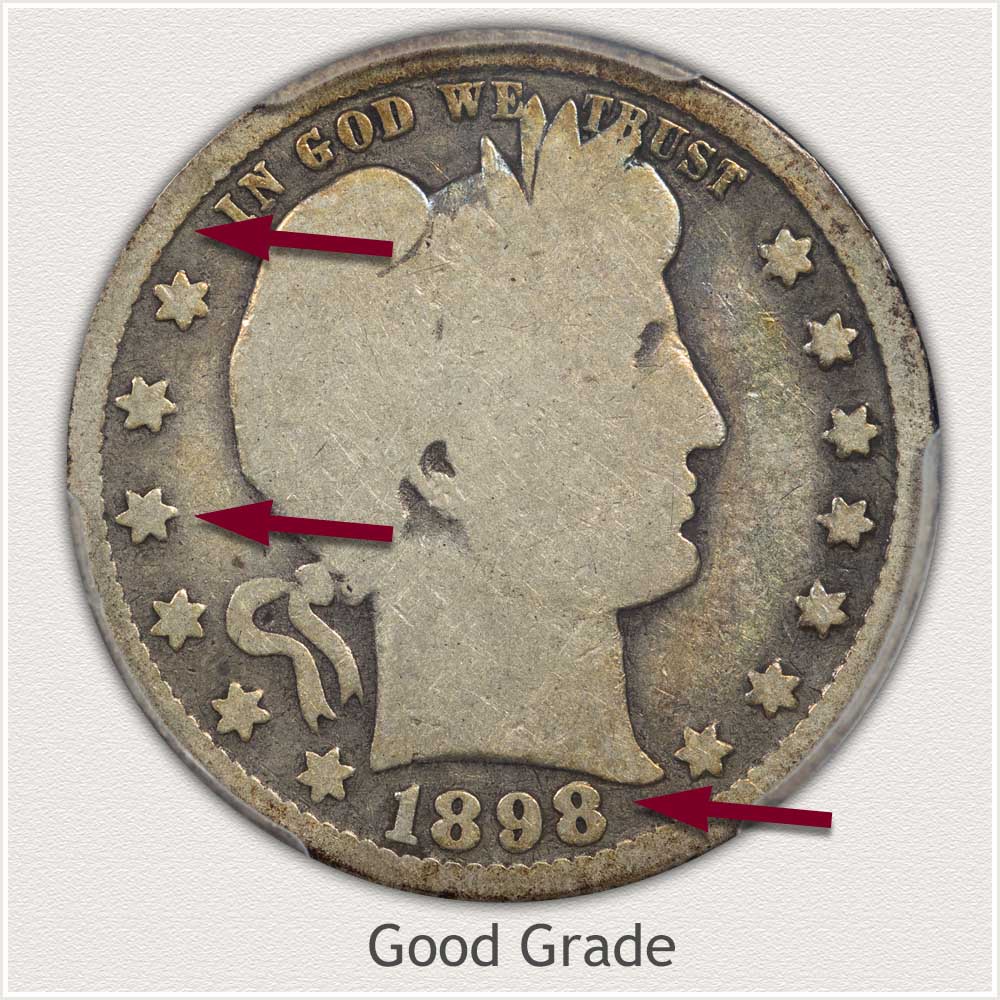
Good Grade: Helping define the Good grade is the strong appearance of Liberty's portrait. Most original details to the design are smooth. However, placing the example well within the grade is the portrait does not fade into the lower fields of the coin.
Although extensive metal and design are worn away, the remaining details are very bold. Stars along the rim are well separated from the rim. The rim itself is clearly defined at its edge, a sharp line with no fading into the field. With a bold date, these coins still retain a nice appearance.
Looking overall at the surface, note the lack of marks and the nice silver-grey color with deeper tones toward the edges. A pleasing look for a well circulated Barber quarter.
How to Video: Grading Barber Quarters
Subtle points of interest when grading is reviewed in the video. Following with images, inspect closely the important features of the coin and judge condition to determine a grade.
Video, Images and Descriptions | Grading Barber Quarters
Step 3: | Special Qualities | Magnified Details
Confirming the High Value of a Scarce 1894 Quarter
When viewing the chart, a clear value separation is seen between a coin in lightly circulated condition when compared to a coin with few details remaining. As condition approaches the Extremely Fine grade a large premium is involved.
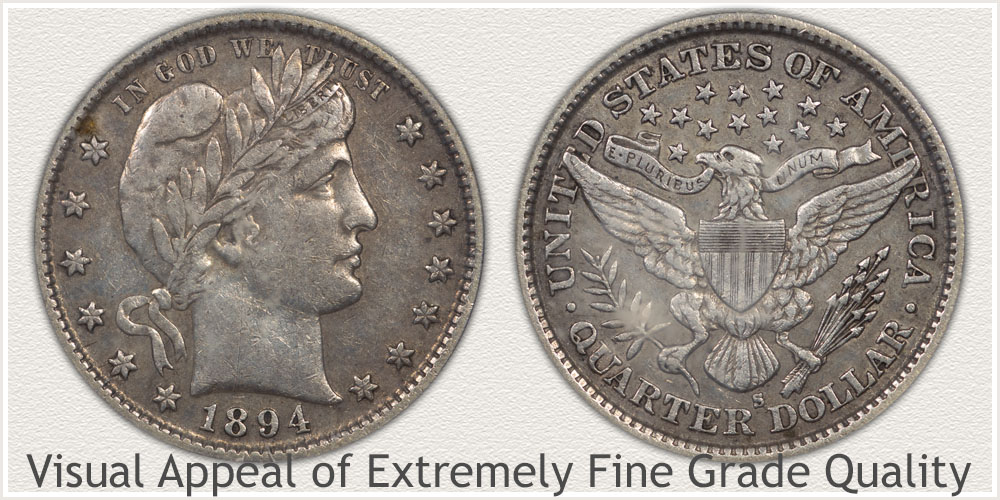
Confirming the Extremely Fine grade is also recognizing a scarce coin, in demand by collectors, and high value. With a close inspection of two distinct areas a confident assessment of this lofty condition is recognizable.
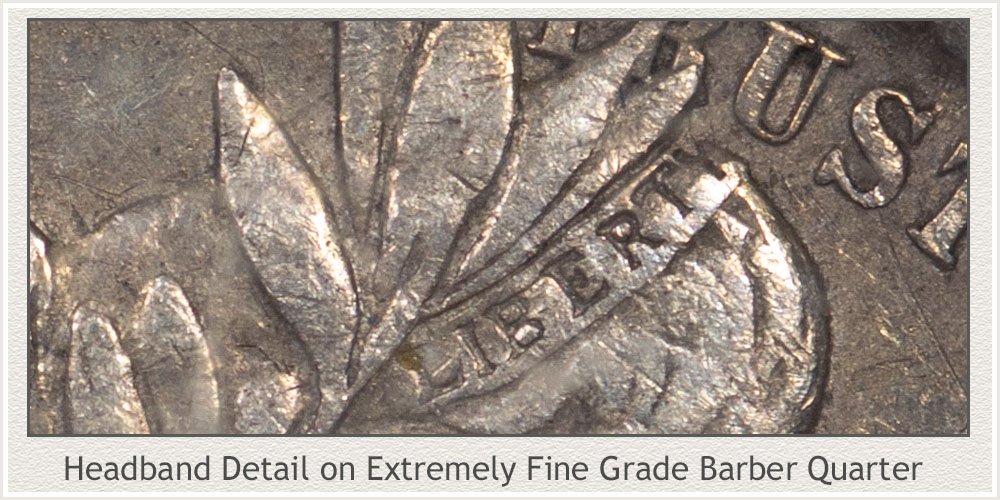
A first overall impression is taken of the coin, and noted as having a pleasing and detailed appearance. These close-up images reveal a small area with very fine detail suspectable to wear. Liberty's head band features all letters of "Liberty" clear and bold. Setting the coin apart is the very strong lower line defining the edge of the ribbon. This small detail is helping confirm a high-quality example with solid consideration of Extremely Fine condition.
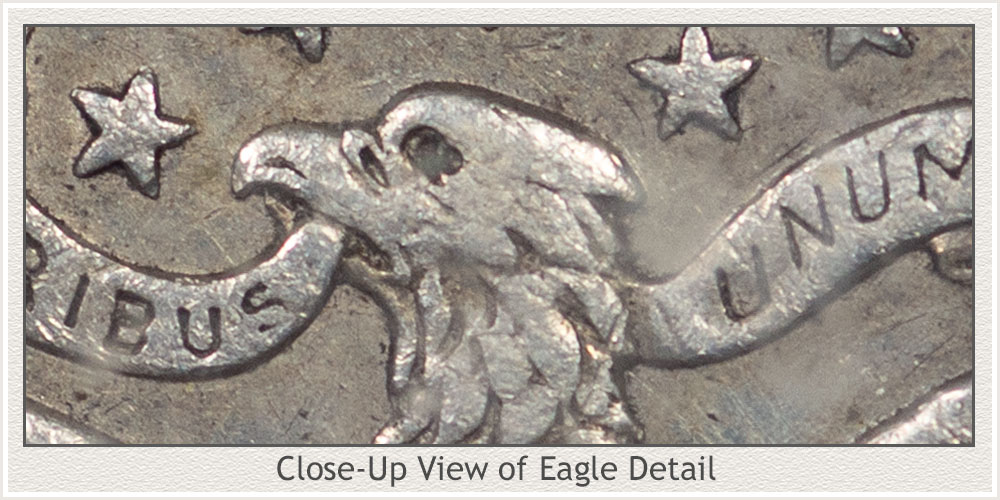
Both sides of the coin are involved in setting the condition well within special quality and suitable to attract the higher values. Taking an overall look of the reverse, many fine lines are visible. Within the shield the horizontal and vertical elements are intact. Feathers appear full with high and low profiles.
The eagle's head is now inspected closely. Part of the original design and impressed into the coin is a line defining his beak from nose, eye, and feathers further back over the neck. A full line visible under the nose, eye and feather features indicates only light wear. This helps strengthen the grade of Extremely Fine.
Using the identifying markers from the obverse of a strong line to the lower ribbon plus the continuous design element defining of the eagle's beak is confirming a strong collectible quality Barber quarter.
A 5x power magnifying glass is used by collectors to recognize small details along with a non-magnified overall impression to arrive at these important value grades.
Adding the alure of a coin minted in the Nineteenth Century and the scarce condition of Extremely Fine or better grade is finding a special quality quarter.
References
U.S. Mint. Catalogue of Coins of the United States
https://nnp.wustl.edu/library/book/554591
U.S. Mint. 1891 U.S. Mint Annual Report
https://nnp.wustl.edu/library/book/512060
U.S. Mint. 1895 U.S. Mint Annual Report
https://nnp.wustl.edu/library/book/514117
Coin Values | CoinStudy Articles
Date by Date
In Depth Barber Quarter Values
1892 to 1916
Barber Quarter Value | Many Scarce Dates
1894 is just one of twenty-five dates to the Barber quarter design series. Each is valued separately on the full value chart. Steps identifying date, mint, and condition lead to finding an accurate place on the chart.
Old Coin Values | Step by Step
Determining the value of a few coins or complete collections follows a similar process. Important factors are recorded, including series, date and mint combinations. Barber quarters are listed and organizes alongside, but separate of other series. Steps are taken in specific order to assure a compete judgement of value.
Print the Coin Values Worksheet
List valuable Barber quarters individually with important date, mint and condition descriptions. Continue with the rest of your collection. Record current values organizing your coin holdings.
Safe Coin Storage | Recommendations
Worn coins show wear, nicks, and marks form use. Mint state coins are at risk of discoloration and darkening over time. Proper storage helps protect, maintain, and preserves condition and values. Collectors use individual and bulk storage options to house their collections and groups of coins.
★Coin Values Discovery finds 1894 Quarter Value and...
All old coin values. Images are used to follow a step by step method when determining how much U.S. coinage is worth. Place a value on your box of old coins.
